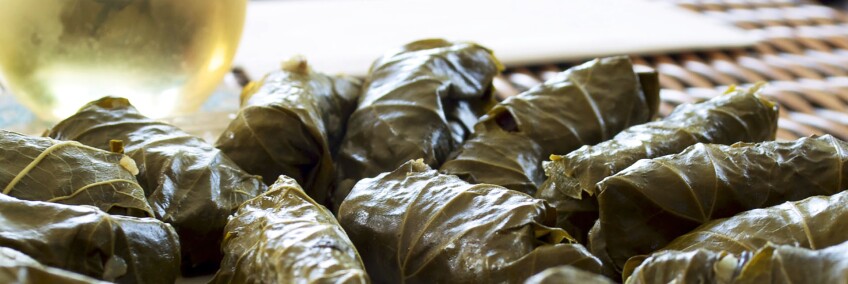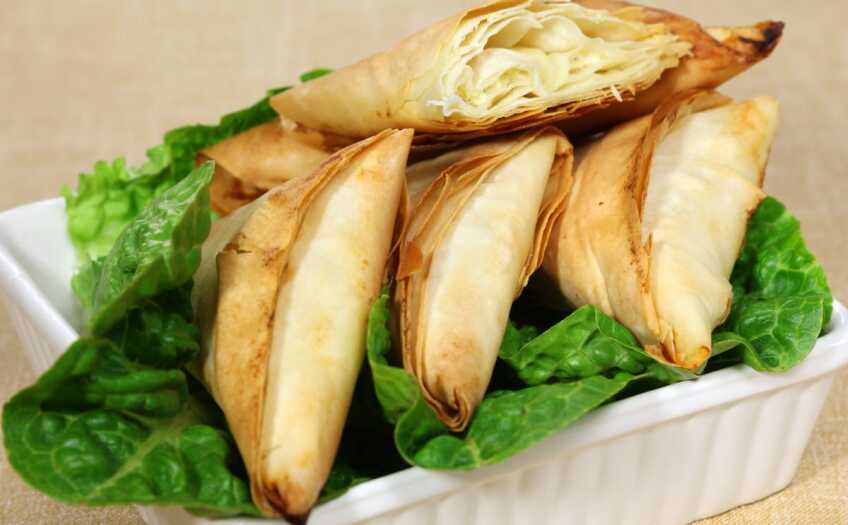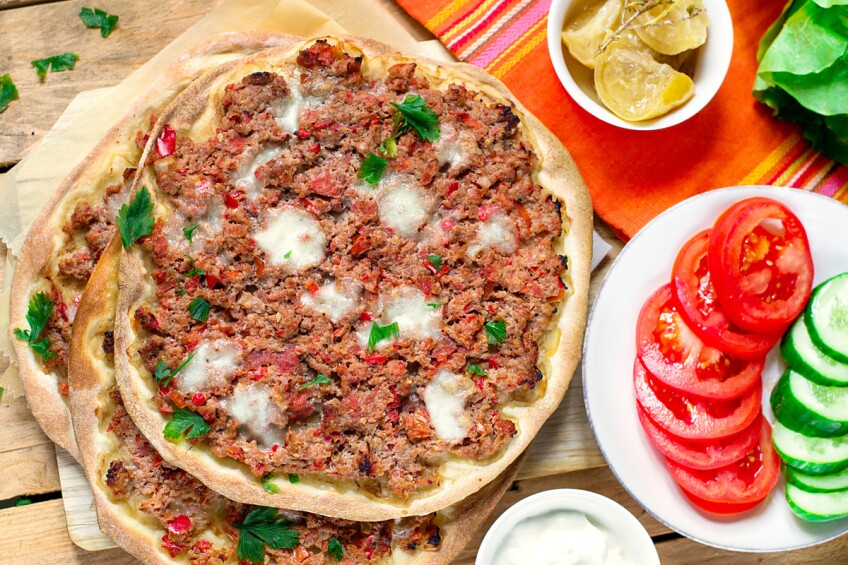Creating a New Armenia in the Kitchen

When I eat my mother’s or my grandmother’s dolmades, I slip into a fugue-like state. Like nostalgia and homesickness, I long to smell the stewing onion and grape leaves. I recall Proust and his description of “those squat, plump little cakes called ‘petites madeleines,’” because the sensation is so singular that I cannot liken it to much else. “But when from a long-distant path,” writes Proust in "In Search of Lost Time," “nothing subsists, after the people are dead, after the things are broken and scattered, taste and smell alone, more fragile but more enduring, more unsubstantial, more persistent, more faithful, remain poised a long time, like souls, remembering, waiting, hoping, amid the ruins of all the rest; and bear unflinchingly, in the tiny and almost impalpable drop of their essence, the vast structure of recollection.”

Like Proust, I too can “hear the echo of great spaces traversed.” I can hear my nene’s shuffling feet on linoleum and enter into a vortex of remembrance (for my childhood) and imagination (for the past that belongs to my ancestry). And by virtue of my nene, it is a past that I have inherited. The one in which 1.5 million Christian Armenians were systematically exterminated during the twilight of the Ottoman Empire by government decree. Our people wanted reform and freedom — basic civil liberties. Instead, they were given two menacing architects (Minister of War Enver Pasha and Minister of Interior Talaat Pasha) of a policy in which Armenians were to be deported from a land that they had spent centuries cultivating. Under the Tehcir Law, the Ottoman Government and the military were effectively given permission to wantonly slaughter. The Armenian Question, for so long debated amongst diplomatic circles, was to be eliminated.

When I close my eyes I see them all standing before me with their brown hair and their big brown eyes. I see my great-great aunts running away from me and throwing themselves into the Euphrates river. My great-great grandfathers bloodied and lifeless in the once bustling streets rife with Armenian intelligentsia, children and clergymen. My great-grandfather, muddied and hungry, hiding in horse stables. My great-great uncle riding valiantly through that forever night with the taste of revenge on his tongue.
Food, like art, conjures up narratives. In some cases, it even serves as a path to salvation. I have always regarded a country’s relationship with food to be reflective of their culture. I, of course, am not the only one. Professions are dedicated to this very act and I now find that my yearning for dolmades (stuffed grape leaves) and basturma (cured dried meat) and lahmajoun (Armenian pizza topped with minced meat) stems from a place that is as primordial as it is psychological. Though I am certainly biased in believing that my family is responsible for some of the finest cuisine that food can yield, I am one of many Armenians who believe that food and the performance of putting together such meals is almost a form of benign protest. Especially for those of us who cannot speak the language. It is as significant as the connective tissue that holds organs in place and weds muscle to bone. It is our way of showing that we have not been defeated.
Though nearly three quarters of the Armenian Christian population were savagely taken from us during the massacres that began in 1915, we are still here to perpetuate what some refer to as “the mythical story of genocide.” The one that ambassadors and missionaries and survivors attested to. The one that has become the defining trait and cause of my people, still one-hundred years on and probably forevermore. One cannot simply forget. The myth is, in fact, reality.
I spent the first twenty-two years of my life in Los Angeles, which harbors the second largest Armenian diaspora community in the world, contending with this reality. For many years, my mother coerced me into standing beside her while she made the meals my nene taught her to make, but I was not happy about it. In my puerile mind, I wanted to rebel against the domestication of women. I was saying, in so many words, that intellect trumps housework. I would not be subjugated. I would not be relegated to the kitchen like my mother and so many other women were. I was profoundly ill-informed. And while I spent countless afternoons accompanying her to Karabagh Meat Market, Sarkis Pastry, and various cousins’ homes in Glendale and Little Armenia, I did so begrudgingly.
I, of course, regard it wistfully now. While Mom and Nene would banter in Armenian with the staff at Karabagh, I would wander, tan in hand, the tang of salt and yogurt in my mouth, and survey the sundry products with labels I was unable to understand. It is difficult to describe now, as I am no longer that child and cannot possibly delineate what kind of world she perceived, the strange, hidden places she would visit in her mind, but I can portray it in broad strokes. It possessed that illusory quality of a world within a world. A trapdoor to another life leaving me both intrigued and uncomfortable.

Upon returning home, Mom and Nene would place the contents of our bounty on the counter: the basturma, the babaganoush, the Armenian string cheese, the boereg (a phyllo dough pastry stuffed with cheese) and all of the ingredients for the dolmades sitting like a still life of our little, against all odds family. I would watch them orchestrate this culinary feat in which chickpeas, basmati rice, tomato paste, dill, parsley, onion, salt and paprika would all coalesce in glossy grape leaves covered in brined solution. Fold, tuck, roll. Fold, tuck, roll. I would watch them, settled into the ease of the ritual, and if I was summoned, I would follow suit. We would then take the unfilled grape leaves and plaster them to the bottom of the pot with olive oil, stack the stuffed wonders into one giant heap on top of them, and submerge it all in water. By the time Dad came home from work, the house smelled of another ancient land. And he would smile a robust smile because that scent was home, vaporized and very much a part of him. All of us.

If done correctly, the dolmades will not fall apart in your hands. They will remain firm, but when they make contact with your mouth, they will have no choice but to surrender. You will be able to easily tear through the grape leaf with your teeth and when you do, the aromatic dill will command your senses. The succulent rice and chickpeas will pleasingly coat your soft palate, the olive oil and brine binding it all together in a confluence of true harmony. Though there are no standout ingredients in this dish, once mixed together and swaddled, the flavor they emit is not only special, but in my opinion, incomparable. Maybe, this is just the “vast structure of recollection” talking.
Now, I crave to cook this food. Unpack it all. Pick it apart morsel by morsel. Reverse engineer until I understand it by its component parts. Like the pieces of our history. Our diaspora.
In attempting to understand my newfound interest in food as vessel, I think of Swiss-born British author Alain de Botton who, in a Guardian article, was quoted saying that what bothers him is that “there is so much emphasis on food, rather than gathering and meeting.” There is also reference to “an almost universal lack of venues that help us to transform strangers into friends,” and it is that venue, however makeshift it may be, the kitchen being the most pronounced of its kind, that I find and inhabit whenever I am in the presence of other Armenians.
A cab, a gas station, a bakery, a bar: these are the spaces of the “New Armenia” that Pulitzer-prize winning writer William Saroyan addresses when he writes about the resilience of the Armenian people. “Go ahead, destroy Armenia,” he writes, “See if you can do it. Send them into the desert without bread or water. Burn their homes and churches. Then see if they will not laugh, sing and pray again. For when two of them meet anywhere in the world, see if they will not create a New Armenia."
Nene's Dolmades
INGREDIENTS
1 cup basmati rice
2 small onions (finely chopped)
1 tablespoon tomato paste
1 jar of grape leaves
Salt and pepper to taste
Juice from one half of a lemon
Half bunch of parsley (finely chopped)
Half bunch of dill (finely chopped)
Half of a can of chickpeas (optional)
Olive oil
1 jalapeño pepper (finely chopped) or dusting of cayenne
INSTRUCTIONS
1. Finely chop the two small onions and sauté with olive oil until translucent over medium heat. At this time, you can also add the finely chopped jalapeño.
2. Add the washed basmati rice and thoroughly mix the grain with the onion, adding a half cup of water.
3. Once the water has evaporated, or after approximately 10 minutes, take the mix off the heat and transfer it all to a large bowl.
4. Add the tomato paste, lemon, salt, pepper, parsley, dill, and chickpeas.
5. Mix thoroughly.
6. Use a large cutting board or flat surface of your choice to lay the grape leaves on for stuffing.
7. Place one teaspoon of the mix into the center of the grape leaf and fold the edges of the leaf over the mix. Roll each into a cigar-like shape.
8. Place a few grape leaves on the bottom of a pan and stack your stuffed grape leaves on top. Add water in order to cover it all, but do not submerge them completely. If you want an added richness, you can add olive oil and beef stock to the water. Then place a sturdy dinner plate directly on top of the heap before placing the pot’s lid on top of it all.
9. Twenty minutes in, check on your stuffed wonders. If the rice is thoroughly cooked, they’re ready to be served.
Top Image: Dolmades | Junkii | Flickr | CC 2.0


